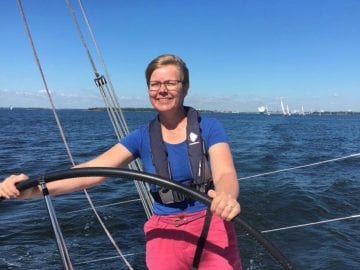State of the Baltic Sea is a priority to the Finnish government

Krista Mikkonen,
Minister of the Environment and Climate Change,
Ministry of the Environment,
Finland
The Baltic Sea continues to suffer from eutrophication, plastic litter accumulates to the sea and underwater noise is a risk to marine mammals and fish. The Baltic is also warming much faster than many other sea areas.
Climate change affects marine life and increases nutrient loss from the catchment area. Although work to improve the state of the Baltic Sea has been carried out for several decades, much still needs to be done.
The Finnish Government considers the protection of the Baltic Sea of importance and has agreed on numerous measures to improve the state of the sea. The government decided to continue a programme of enhancing the effectiveness of water protection, with altogether 69 million euros reserved for its implementation between 2019 and 2023. Already over 100 water restoration projects have been initiated and water protection within the agricultural sector is enhanced by spreading gypsym, structural lime and fiber sludge to agricultural fields to reduce loss of phosphorus into waterways.
Longer-term work to protect the marine environment and surface waters has been organised with Finland’s River Basin Management Plans and the national Marine Strategy. The goal is to achieve and maintain a good status of surface waters and the marine environment. A multitude of actors in the society participate in the implementation of the measures contained in the River Basin Management Plans and the Marine Strategy. The Plans and the Strategy will be updated for years 2022 – 2027.
Archipelago Sea in the South-West of Finland has been in special focus during recent years. The program of enhancing the effectiveness of water protection aims to spread gypsum to over 60000 hectares of agricultural land in the catchment of the Archipelago Sea, in order to reduce the level of annual loading of phosphorus by 44 tons from the current loading of about 480 tons. The effect of gypsum lasts for about five years.
In 2021, the Ministry of the Environment will initiate an assessment of the possibility to remediate Finland’s only remaining HELCOM hotspot on the agricultural diffuse loading from the catchment of the Archipelago Sea. The objective is to evaluate whether existing measures and actions are sufficient to reduce nutrient loading to the sea, improving the state of the marine waters as defined in HELCOM’s criteria for hot spots, or whether more measures are needed. Depending on the results of the analysis, measures will be planned to fulfil potential gaps.
To improve the state of the whole Baltic Sea, action by all coastal countries and cross-border collaboration is crucial. The Finnish Government strives for stronger international environmental cooperation in the Baltic Sea region. For Finland, central forms of environmental cooperation include HELCOM and cooperation within the framework of the EU Strategy for the Baltic Sea region.
The update of HELCOM the Baltic Sea Action Plan was initiated under the Finnish Chairmanship of HELCOM in 2018 – 2020. The updated Plan is to be adopted by the HELCOM Ministerial Meeting in October 2021, with a view to containing measures that will enable achieving and maintaining a good status of the Baltic Sea.
Cooperation between EU Member States in the Baltic Sea region to implement the Marine Strategy Framework Directive and Maritime Spatial Planning Directive is an important contribution to enhancing action to protect the Baltic.
I want to stress the need for cooperation and dialogue between different economic sectors affecting the sea. The EU Ministers of environment, agriculture and fisheries met in September 2020 to discuss joint action to improve the state of the Baltic Sea. The particular topics discussed by this Conference were eutrophication, marine litter and impact of fisheries. At the Conference, Ministers signed a declaration, pledging to take further action on EU level and strengthen their commitment to the present measures on the EU level that aim at improving the state of the Baltic Sea.
Protection of the Baltic Sea is long-term work and climate change poses an extra challenge. There are, nevertheless, sparks of hope at sight. Since the beginning of the 1990’s, the trend of the total nutrient load to the Baltic has been declining. The status of many species, such as the grey seal and the white-tailed eagle, has improved notably due to protection measures. Situation in the eastern Gulf of Finland is now much brighter due to improved wastewater treatment in Saint Petersburg. We need to continue cooperation across national borders and economic sectors to achieve more successes like these!
Expert article 2855
> Back to Baltic Rim Economies 1/2021
To receive the Baltic Rim Economies review free of charge, you may register to the mailing list.
The review is published 4-6 times a year.
